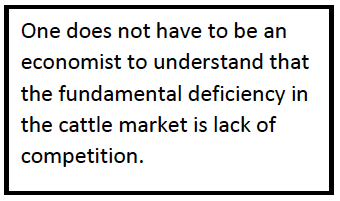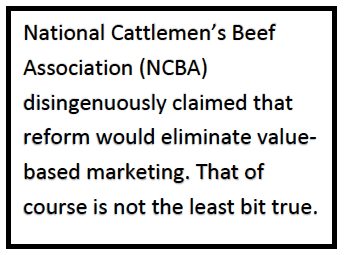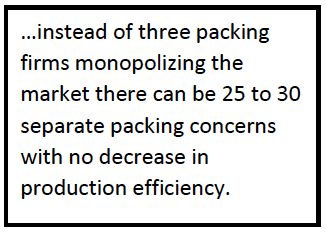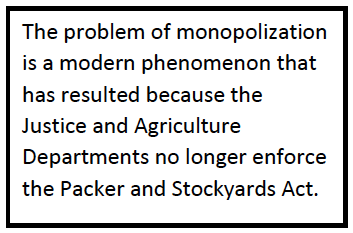
Captive Supply Reform
September 23, 2019
Feeders and ranchers alike have every reason to be upset at the hit cattle prices took following a fire in a Tyson slaughter plant back in August. We can’t call this downturn a collapse because the collapse came in 2015 when Congress rescinded Country of Origin Labeling (COOL). However, we were all hopeful that the market for feeder calves would be modestly increased over the previous years depressed prices. The fire dashed that hope.

Various articles in the Ag papers have advanced different ideas for fixing the market. The most comprehensive has been proposed by the Organization for Competitive Markets (OCM) which calls for: “Six Actions Sonny Perdue Can Take to Save the U.S. Cattle Market.” All six actions proposed by OCM are important and need implementation, however, their list omits the seventh – the only action that would actually restore competition to this non-competitive dysfunctional cattle market.
This solution was first advanced in 1997 by the Western Organization of Resource Councils (WORC) and was published in the Federal Register (Vol. 62. No. 9. Tuesday 14, 1997). The concepts proposed by WORC were subsequently picked up in The Captive Supply Reform Act (110th Congress, 1st Session S -1017) sponsored by Senators Tester, Enzi, and Johnson. A comprehensive solution, therefore, exists; what does not exist is a coordinated campaign to make the solution a reality. The solution as advanced by WORC is short in words but by no means simple in its implications:
No packer shall procure cattle for slaughter through the use of a formula or basis price forward contract. All forward contracts used by packers for purchase of cattle slaughter supplies shall contain a firm base price that can be equated to a specified dollar amount at the time the contract is entered into and be offered or bid in an open, public manner.
No packer shall own and feed cattle unless those cattle are sold for slaughter in an open, public market.
One does not have to be an economist to understand that the fundamental deficiency in the cattle market is lack of competition. In fact, it might help to not be an economist because most economists have been un-helpful in defining the problem or proposing solutions. The mechanism that the three dominate packing firms use to manipulate the cattle market are captive supplies – cattle that the packers either own outright or have committed for future delivery without ever having put a base price on them. Captive supply cattle are eventually priced on the average of the “spot market” at the time of delivery.

The problem is that the “spot market” upon which these captive supply cattle are priced is so small as to not represent the real value of the cattle. This miniscule “spot market” is easily manipulated and subject to shocks such as the fire in the Tyson plant. The solution as proposed by WORC is simple – the market for fat cattle should be open, transparent, and competitive. This is easily and inexpensively accomplished through electronic/video markets similar to those that cow-calf producers commonly use to market feeder calves. Rather than have a market based on a miniscule manipulated “spot market” all fat cattle would be subject to competitive market forces. The market information would by definition be transparent which means that anomalies in prices would be instantly apparent.
The legal basis for this solution is the Packers and Stockyards Act. Section 202 which reads in part:
It shall be unlawful with respect to livestock … for any packer… to:
(a) Engage in or use any unfair, unjustly discriminatory, or deceptive practice or device;
or
(b) Make or give any undue or unreasonable preference or advantage to any particular
person or locality in any respect whatsoever, or subject any particular person or locality to any
undue or unreasonable prejudice or disadvantage in any respect whatsoever; or …
(e) Engage in any course of business or do any act for purpose or with the effect of
manipulating or controlling prices, or of creating a monopoly in the acquisition of, buying,
selling, or dealing in, any article, or of restraining commerce.
The language is plain. If a packer feeds and slaughters cattle they own they are giving themselves “undue preference.” If a packer has a secret arrangement with a feedlot to give them a premium not available to other feedlots, they are giving that feedlot “undue preference” and competing feedlots “unreasonable disadvantage.” If packers engage in activities with “… the effect of manipulating or controlling prices” they are in violation of the Packers and Stockyards Act. Intent does not matter if the “effect” is to manipulate the market.
Predictably, opposition to captive supply reform came from the National Cattlemen’s Beef Association (NCBA) which disingenuously claimed that reform would eliminate value based marketing. That of course is not the least bit true. It is understood that each packing plant needs to know in advance the numbers and timing of cattle available to them in order to plan operations. The best way to accomplish this is through forward contracts. Captive supply reform only requires that a base price be set at the time of forward contracting. Premiums for high yielding quality cattle can be easily written into the contract, compensating producers for the value they offer through breeding and nutrition.

Some might legitimately wonder that because there would still be only three packers there will still not be adequate competition to improve prices. That is initially true. However, introducing captive supply reform allows for startup packers to compete on an equal basis with the big guys. It has been determined by those who study these things, that one modern packing plant meets all economies of scale. This means that instead of three packing firms monopolizing the market there can be 25 to 30 separate packing concerns with no decrease in production efficiency.
Introducing captive supply reform allows for the cattle industry to evolve to a structure that is truly efficient. This was the approach taken by the Justice Department in 1921. Instead of breaking up the packing cartel of that era they required that packers buy their cattle supplies in a transparent competitive manner. The packing segment of the cattle industry was actually at its least concentrated in 1975. The problem of monopolization is a modern phenomenon that has resulted because the Justice and Agriculture Departments no longer enforce the Packer and Stockyards Act.

Obviously, the packers Achilles heel is the Packers and Stockyards Act. That the Act continues to be ignored points to how corrupt this nation’s political system has become. None of the reforms currently proposed will be easily enacted because the packers will fight tooth and nail to stop all of them. Just look at how they were able to nullify Country of Origin Labeling (COOL), a commonsense measure that both consumers and livestock producers overwhelmingly support.
Organizations representing cattle producers fought for COOL for twenty years. We had it and then we lost it. The trap that the packers set forced organizations representing livestock producers to put all of their resources in defending COOL because COOL seemed to be the easiest to enact. But because our organizations often do not work in a coordinated fashion, they (we) lost on all counts. Meanwhile the dysfunctional market continues to put independent feedlots and cow/calf producers out of business.
Each one of the currently proposed reforms are needed to fix the cattle market. However, none actually restores competition except the proposal originally advanced by WORC in 1997. We all know it will be a tough fight, and we all know that our resources are limited. It is not a matter of doing a triage and saying we shall work for only this reform and not those. We need to fight for all of them as a block and we need that all likeminded organizations support each other in a unified approach. Benjamin Franklin said it: “We must, indeed, all hang together or, most assuredly, we shall all hang separately.”
Gilles Stockton
Stockton Ranch
Grass Range, Montana
406 428-2183
gillesstockton@gmail.com












